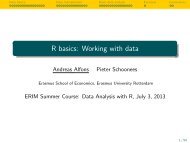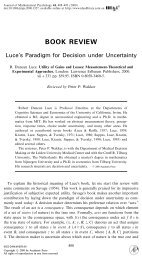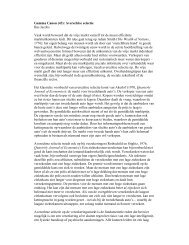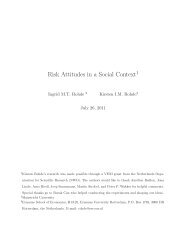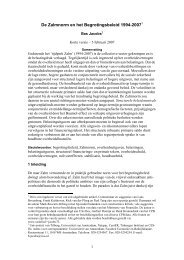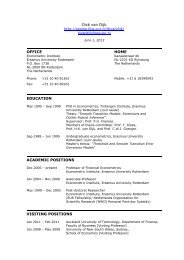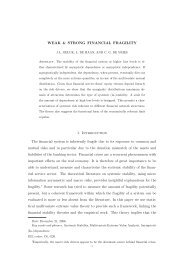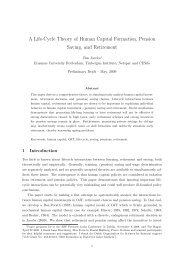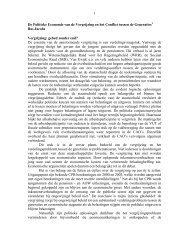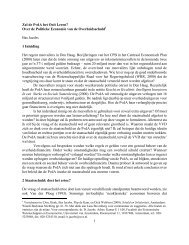Download PDF
Download PDF
Download PDF
You also want an ePaper? Increase the reach of your titles
YUMPU automatically turns print PDFs into web optimized ePapers that Google loves.
higher wage level will give an incentive to switch between jobs and consider working (again) in<br />
an S&E profession. The second channel is that current S&E workers may decide to work more<br />
hours in their current occupation when it becomes financially more rewarding. The third<br />
channel is new entry of workers on the labour market. An increase in wages for scientists and<br />
engineers provides incentives for students to enrol in S&E fields because the relative benefits<br />
being an S&E worker compared to other jobs improves. Although clearly there is a delay, since<br />
it takes a few years to train a student into an S&E worker, the economic literature is conclusive<br />
30 31<br />
on a positive relation between pay and enrolment.<br />
56<br />
The wages for S&E workers will adjust until demand and supply are equalised and the<br />
market for S&E workers clears. Indeed, shortages will disappear because prices increase if S&E<br />
workers become scarcer. This is efficient because scarce resources are allocated to activities<br />
where their marginal benefits are highest and low-productive activities will be stopped. At<br />
higher wages, firms demand less workers because they have become too costly and some<br />
workers will find it attractive to apply for a job as an S&E worker. This process of rising wages<br />
continues until supply and demand will be equilibrated.<br />
The responsiveness of firms or workers to increasing wages is denoted by the elasticity of<br />
demand or supply. The elasticity measures the percentage-wise change in demand (or supply)<br />
with respect to a percentage-wise change in the wage. If supply is inelastic, that is, when<br />
workers do not react strongly to increasing wages, firms may demand more workers, but this<br />
only results in higher wages, not in more hires of S&E workers. Or, in other words, they need to<br />
increase wages a lot to attract new workers. If, on the other hand, supply is elastic, firms<br />
demanding more workers need to offer only slightly higher wages to attract a lot of potential<br />
employees.<br />
As long as the market clears, there can be no ‘shortages’ in a literal sense because supply<br />
always equals demand if the market is in equilibrium. The only thing economists can say is that<br />
S&E workers have become scarcer if their wages are higher. If S&E workers are scarcer, their<br />
wages will go up. If there is ample supply, wages must come down. Although, markets can be<br />
out of equilibrium temporarily, economic forces will ensure convergence to equilibrium in the<br />
long run, unless there are all kinds of market distortions. See also the box in this section.<br />
From this discussion follows that the definition of a ‘shortage’ is not well defined in an<br />
economic sense. Following RAND (2003), one could easily identify various types of<br />
‘shortages’. In the short run, supply could indeed be too low to meet demand. But, market<br />
forces would normally eliminate these shortages in the long-run.<br />
30 See for instance the recent paper by Ryoo and Rosen (2004) about the labour market for engineers in the US. They show<br />
that the demand for engineers is very responsive to their price (i.e. wages), but also that supply is equally sensitive to future<br />
earnings. The observed time lag is about four years.<br />
31 Obviously, there are other elements which determine the relative attractiveness of a certain profession, like innate<br />
capacities, interests, training possibilities, social standing, non-wage benefits, etcetera. Often the latter are part of a package<br />
including an attractive wage.



